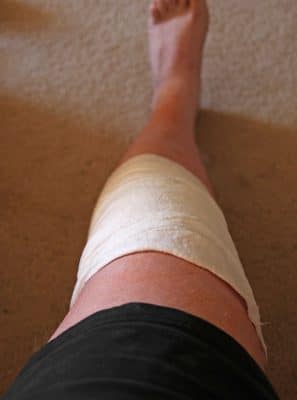Knee Surgery
Knee i njuries are very common. Many of you reading this may know someone who has, or have yourself, received a knee injury from team sports, outdoor recreation, or a bad accident. The knee is a complex and vital joint; an overview of how it works is necessary to understand how it can be injured and how surgery fixes those injuries. Essentially, the knee is where the femur meets the tibia, or where the thigh bone meets the leg bone. This intersection is cushioned by the meniscus, a fibro-cartilaginous disc that facilitates movement and keeps the bones from colliding during use. The patella (kneecap) protects the joint and is held in place by ligaments. The bones are connected by ligaments including the posterior and anterior cruciate ligaments (the PCL and ACL respectively, not shown). Damage to the meniscus and strains or tears of the ligaments are among the most common knee injuries; they can be treated with physical therapy, but more severe injuries require surgery and lengthy rehabilitation to heal fully.
njuries are very common. Many of you reading this may know someone who has, or have yourself, received a knee injury from team sports, outdoor recreation, or a bad accident. The knee is a complex and vital joint; an overview of how it works is necessary to understand how it can be injured and how surgery fixes those injuries. Essentially, the knee is where the femur meets the tibia, or where the thigh bone meets the leg bone. This intersection is cushioned by the meniscus, a fibro-cartilaginous disc that facilitates movement and keeps the bones from colliding during use. The patella (kneecap) protects the joint and is held in place by ligaments. The bones are connected by ligaments including the posterior and anterior cruciate ligaments (the PCL and ACL respectively, not shown). Damage to the meniscus and strains or tears of the ligaments are among the most common knee injuries; they can be treated with physical therapy, but more severe injuries require surgery and lengthy rehabilitation to heal fully.
Table of Contents
Common Surgeries
- Meniscectomy and Meniscus Repair— The removal of all or part of the meniscus. If the meniscus is damaged or torn, it will swell and impede movement. It will also cause pain in the area and can do permanent damage to the joint. Removal of the Meniscus is generally well tolerated, particularly in older and less active patients, but the load-bearing capability of the joint decreases with the portion of meniscus removed. This effect can be, in part, remedied by strengthening the muscles around the joint. This kind of surgery is usually done through the minimally invasive technique called arthroscopy and is typically an outpatient procedure, although open knee surgery may be required. Patients usually report a return to normal functionality (minus the decreased load bearing ability) after four or five months of physical therapy. For more information, use a trusted source like WebMD.
- ACL Reconstruction— This is a very common surgery for athletes and young, active people. The anterior cruciate ligament supports the leg when the knee is fully flexed and is one of the ligaments connecting the femur and tibia. During surgery, the muscle is reconstructed using grafts from the patellar tendon, the calf muscle, or a donor (deceased). Surgeons will do their best to reduce surgical damage and recovery time, thus this surgery is usually performed arthroscopically. Any arthroscopic surgery is most likely an outpatient procedure, but ACL damage often occurs concurrently with other damage so an extended recovery period is not uncommon. Physical therapy can last from several months to a year, depending on the patient. Minor strains and tears can be treated with rest and physical therapy alone, particularly if the patient is willing to change his lifestyle in ways that reduce impact to the knee. To find out if surgery is right for you click here.
- Total and Partial Knee Replacement— Total knee replacement surgery is becoming more and more popular. Now more than ever, adults are staying active and expecting to get more and more out of their bodies, even as they become older. According to AARP the number of knee replacements went up by 30% between 2004 and 2008, in the same period of time, knee replacements for men and women age 45–64 rose by 61%. During a total knee replacement, the doctors will remove damaged bone, cartilage and one ligament, replacing them with a prosthesis. In a partial knee replacement, the surgeon only replaces specifically the damaged area. Despite the onward march of medical technology, any joint replacement is a last option. Physicians consider strength training, lifestyle changes, pain management, and arthroscopic surgery as preferable to a joint replacement. They recommend that patients consider whether or not their symptoms are bad enough to warrant undergoing surgery and recovery. With a total knee replacement (the most common of the two) recovery time is about three days in the hospital and one or two weeks at home. Recovery is followed immediately by physical therapy, which lasts for six months to a year. For more information, I suggest you read this page about what to expect following surgery. In spite of the initial pain and challenging road to recovery, knee replacements can effectively cure chronic pain due to arthritis and joint damage, and help patients return to a normal life.
Costs
The average total knee replacement, in the US, costs $49,500 with the complete hospital bill ending up around $57,000 (according to healthline). A partial knee replacement will cost about 20% less, depending on where you live. An arthroscopic meniscectomy costs anywhere from $5,400 to $36,700, with an average cost of $13,000 (according to new choice health). And ACL reconstruction proffers an average bill of $35,000. While these numbers may seem daunting, they represent total medical costs and not the average out of pocket cost for an insured person. These figures do show, however, just how important it is to ensure you’re getting the most out of your insurance. If they’re not offering enough to cover your treatment, or if you were wrongly injured, it is essential to seek legal counsel so you can focus on recovery and not on medical expenses.
Photo “Knee surgery – March 2010 – 0005” copyright by Tim Evanson.
Free Consultation
Learn your Rights. Get Answers. Free.
